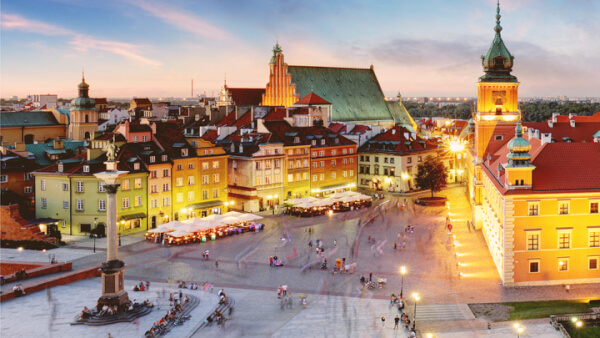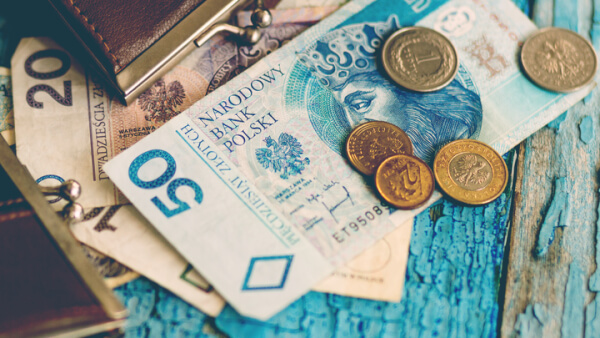Is it better to use cash or card in Poland?
Should you pay with cash or card in Poland? A handy guide including cash etiquette, Polish ATMs and using your UK card.

Planning a trip to Poland? Whether you’ll be going on a city break or visiting Polish national parks, you’re probably thinking about the details of your travel budget as well.
In this guide, we’ll tell you what is the best currency to take to Poland from the UK. We’ve also included information about the accepted payment methods in Poland and which one is the best option for your stay.
We’ll also show you a handy alternative to cash, the Wise debit card from the money services provider Wise. It’s designed for low-cost spending around the world in 150+ countries, automatically converting your pounds to Polish zloty at the mid-market exchange rate, only adding a small, transparent currency conversion fee. Or it’s free if you already have the foreign currency in your Wise account.
When travelling to Poland or anywhere abroad, it’s best to have the destination country’s official currency with you. This will help you avoid unnecessary exchange fees and any extra charges. The currency used in Poland is the Polish zloty and each zloty is subdivided into 100 grosz.
Although Poland has been a member of the EU for a while, it’s not in the Eurozone. If you see that some Polish businesses accept euros, keep in mind that a markup is probably included in their prices. Even if it seems more convenient for you to pay in euros, we recommend always paying in Polish zloty.
There’s no need to exchange currency ahead of arriving in Poland, especially if you have a Wise debit card. You’ll be able to find plenty of exchange offices and ATMs once you get there. If you wish, you can bring a small amount of Polish zloty with you just to get you through your first day.
We advise against exchanging currency at the airport unless you absolutely must do so. Airports are known for having unfavourable exchange rates and high markups. It’s better to visit any bank in Poland instead.
When creating a travel budget for Poland, it’s important to take multiple factors into consideration. Your travel preferences and where exactly in Poland you’ll be visiting are just some of them. Since the cost of living there is significantly lower than in the UK, you’ll surely be able to make the most out of your money.
A three-course meal for two in Poland costs £32 or zł160 on average. If you go to a more budget-friendly restaurant, the average bill will be around £7 or zł35. Sitting down for a beer or a cup of coffee will set you back around £3, which is just under zł15.²
For example, an average Warsaw visitor spends around zł258 per day, excluding accommodation. Your own spending habits will determine your final budget, but this might serve as a good starting point.³
| 📚 Read more: Best ways to spend money while travelling abroad |
|---|
All commonly accepted payment methods are used in Poland. This includes credit, debit and prepaid cards, different apps and finally, cash.
Cash is still the most frequent payment method, even though its use has dropped significantly in the past few years. Instead, the popularity of debit cards is on the rise, accounting for almost 40% of all transactions.
Digital wallets are being used in around 13% of transactions. This includes both well known services, such as Google Pay, as well as local payment apps like BLIK. You can also pay with your credit card in Poland, even though Polish people don’t use them as often.

If you’re wondering whether you should bring cash or cards to Poland, the answer is - both, if possible. They’re used equally and it’s best not to rely on only one.
Although cashless methods are popular in Poland, having some paper money on you is still a good idea. It can come in handy for tips and small payments, as well as street food or souvenirs. Also, if you plan on going off the beaten path and leaving tourist areas, cash might even be the only option available.
Cards and digital payments are accepted pretty much anywhere, and using your credit card is safer than carrying large amounts of cash with you. Just make sure you always choose to pay in the local currency when asked.
Prepaid travel cards and debit cards are a good option if you’re trying to stay on budget. Some cards, like the Wise debit card, can convert your pounds to zloty automatically, with only a small conversion fee, so you don’t have to worry about exchanging currency in advance.
Sources used:
Sources last checked on date: 13-May-2024
*Please see terms of use and product availability for your region or visit Wise fees and pricing for the most up to date pricing and fee information.
This publication is provided for general information purposes and does not constitute legal, tax or other professional advice from Wise Payments Limited or its subsidiaries and its affiliates, and it is not intended as a substitute for obtaining advice from a financial advisor or any other professional.
We make no representations, warranties or guarantees, whether expressed or implied, that the content in the publication is accurate, complete or up to date.

Should you pay with cash or card in Poland? A handy guide including cash etiquette, Polish ATMs and using your UK card.

This article gets you one step closer to your affordable vacation in Poland by detailing your options for VAT refund in Poland as a tourist.

Read our essential guide to ATMs in Poland, including how to find them, fees, exchange rates, withdrawal limits and more.

If you’re looking for a city with a taste of the unexpected, Warsaw won’t disappoint. The Polish capital is a city of fascinating contrasts: Modernist...

The official currency is Polish Zloty. This guide covers the best ways to exchange your money. And, looks at if you can use euros too.